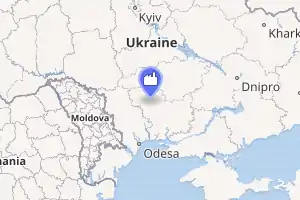South Ukraine Nuclear Power Plant
The Yuzhnoukrainsk Nuclear Power Station (Ukrainian: Южноукраїнська АЕС, Russian: Южноукраинская АЭС), is a nuclear power station in Ukraine. It is part of the South Ukrainian Energy Complex.
| Yuzhnoukrainsk Nuclear Power Plant | |
|---|---|
.jpg.webp) | |

| |
| Country | Ukraine |
| Location | Yuzhnoukrainsk, Mykolaiv Oblast |
| Coordinates | 47°49′0″N 31°13′0″E |
| Status | Operational |
| Construction began | Unit 1: August 1, 1976 Unit 2: July 1, 1981 Unit 3: November 1, 1984 |
| Commission date | Unit 1: December 2, 1983 Unit 2: April 6, 1985 Unit 3: December 29, 1989 |
| Owner(s) | Energoatom |
| Operator(s) | Energoatom |
| Nuclear power station | |
| Reactor type | PWR |
| Reactor supplier | Atomstroyexport |
| Cooling source | Tashlytske Reservoir |
| Thermal capacity | 3 × 3000 MWth |
| Power generation | |
| Units operational | 3 × 950 MW |
| Make and model | VVER-1000/302 VVER-1000/338 VVER-1000/320 |
| Nameplate capacity | 2850 MW |
| Capacity factor | 65.56% |
| Annual net output | 16,367 GW·h (2016) |
| External links | |
| Website | www.sunpp.mk.ua |
| Commons | Related media on Commons |
It is located near the city of Yuzhnoukrainsk in Mykolaiv province, approximately 350 kilometers (220 mi) south of Kyiv. The nuclear power station has three VVER-1000 pressurized water reactors and a net generation capacity of 2,850 megawatts (MW). It is at present the second largest of five nuclear power stations in Ukraine.
From South Ukraine Nuclear Power Plant a 750 kV powerline runs to Isaccea, Romania, but it is mostly dismantled or ruined.
In 2013, following major upgrade work, unit 1 was given a 10-year license extension, which will take it beyond its original 30-year design lifetime. Similar extensions are planned for units 2 and 3, licensed until 2015 and 2019, respectively.[1]
Fuel supply
The main supplier of fuel for nuclear power plants in Ukraine has been TVEL, with whom NNEGC signed a contract for the supply of nuclear fuel for Ukrainian WMR in 1997 until 2010.
Under a US-Ukrainian initiative to reduce Ukraine's dependency on Russia for fuel, tied to the dismantling of its nuclear weapon arsenal, Energoatom had been using reactor core of unit 3 to test nuclear fuel produced by Westinghouse Electric Company in Västerås in Sweden, mixed with Russian assemblies. In August 2005, it was loaded with the first six experimental fuel assemblies produced by Westinghouse together with Russian fuel for a period of pilot operation. The pilot runs were "deemed unsuccessful, with Energoatom claiming manufacturing defects in the fuel led to a lengthy unscheduled outage at two of the units, while Westinghouse said that errors had been made during fuel loading."[2] Nevertheless, in 2008 Energoatom signed a fuel supply contract with Westinghouse to supply 630 nuclear fuel assemblies to its three reactors starting in 2011. Westinghouse shipped a reload batch of 42 fuel assemblies for the 3 units in mid-2009 to last for three years of commercial operation. In June 2010, Energoatom signed a long-term fuel supply contract with Russia's TVEL for its nuclear reactor fleet. Earlier, Rosatom had offered a substantial discount to Ukraine if it signed up with TVEL for 20 years.
During trial use of Westinghouse manufactured fuel in 2012, the fuel became deformed and caused serious damage to the reactor.[3]
On 11 April 2014, after the Russian annexation of Crimea, the fuel contract with Westinghouse was extended through 2020. The fuel will be made at the fuel fabrication facility in Västerås.[2]
See also
References
- "Life extension for South Ukraine unit 1". World Nuclear News. 10 December 2013. Retrieved 12 December 2013.
- "More Westinghouse fuel for Ukraine". website. World Nuclear News. 11 April 2014. Retrieved 16 April 2014.
- "Westinghouse to continue fuel deliveries to Ukraine". Nuclear Engineering International. 3 April 2017. Retrieved 4 April 2017.
External links
| Wikimedia Commons has media related to South Ukraine Nuclear Power Plant. |